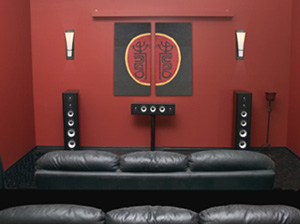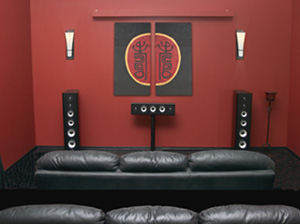Why You Need More Than Two Loudspeakers
In real life, our ears and brain interpret sounds from every direction, in a 360-degree circle, including even the dimension of height. Like a super computer running in high gear, our sophisticated hearing system decodes spatial and directional information in real time, telling us instantly the tonality, frequency content, and loudness of sounds from all directions.

Simple stereo, on the other hand, uses just two speakers at the front left and right, to try and simulate the complex directional and spatial information that we hear in real life. It does a decent job of reproducing a musical event, even fairly impressive at times. But it is limited to those two boxes up front, and two directions, give or take a bit. Even as early as the 1930s, Bell Telephone scientists concluded that a minimum of three channels were necessary to convey a reasonable simulation of an orchestral performance—two channels at the left and right, and one in the middle.
In the late 1950s and '60s, Hollywood sound engineers realized that more channels of sound were better, and added magnetic stripes to the edge of epic 70mm widescreen movies, which delivered up to six separate "tracks" or sound channels. Audiences loved the effect: Multiple channels more closely approximated the multidirectional sounds our ears pick up in everyday life. There was a center channel behind the screen for the actor's dialogue; left and right front speakers for the music, and eventually, left and right surround speakers on each side of the movie theater for ambient sounds-the wind in the trees, crickets in summer, and the howling of wolves. Yikes!
But back then, home audio technology wasn't up to the task of duplicating these events in our living room. Now it is, and it's called "Home Theater"! First came Dolby Surround, with four channels, in the 1980s, and now we have Dolby Digital 5.1-channel sound on virtually every movie issued on DVD. That's six separate or "discrete" channels of sound: left and right front main channels (like stereo), a dedicated center channel speaker for dialogue to anchor the actor's voices at the TV screen no matter where you're sitting, two left and right surround speakers at the sides of your listening area for all those ambient environment sounds, and a sixth deep bass subwoofer channel—it's the ".1" in 5.1—which contributes the shakes and shudders of thunder, explosions, and powerful musical bass effects. If you've kept count, that's a total of five "satellite" speakers—plus one subwoofer for ultra-low bass. Now you see why we need six speakers. And those engineers are working on one more, for height!

Now you know what it is . . . so what do you need? Click here to send an email to our audio experts for a recommendation based on your room size and listening preferences, or contact us toll-free at 1-888-352-9466 for fast, free, friendly advice.
Read related articles:
Home Theater Basics: Buying A DVD Player
Home Theater Basics: Home Theater Components






